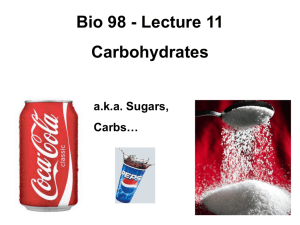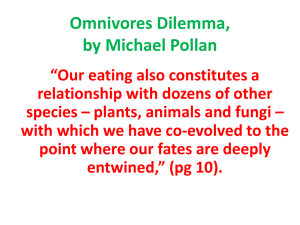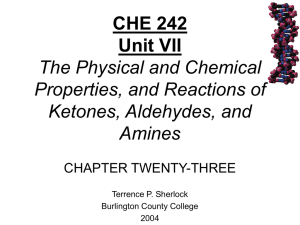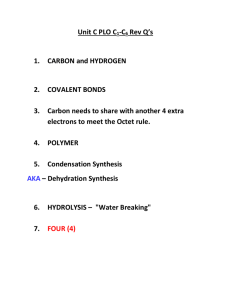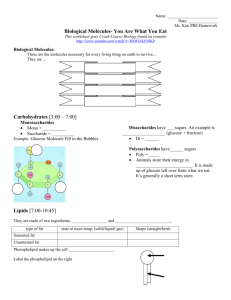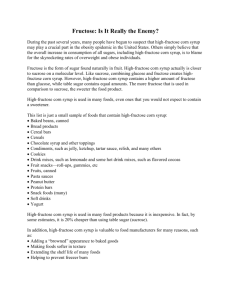Bio 98 - Lecture 11 Carbohydrates
advertisement
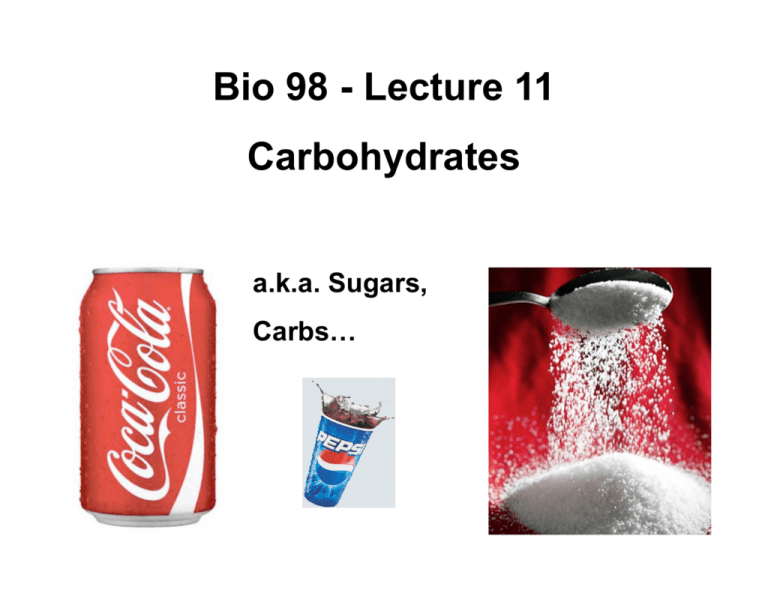
Bio 98 - Lecture 11 Carbohydrates a.k.a. Sugars, Carbs… I. Definition of a carbohydrate General formula: (CH2O)n , hydrated carbon Example: C6H12O6 is glucose Many carbohydrates have more complex formulas & contain amino, phosphate, sulfate & other groups II. Functions 1. Fundamental source of metabolic energy for most life forms. 2. Components of many important biomolecules. 1. Carbohydrates as an energy source sunlight bacteria plants photosynthesis carbohydrate + O2 CO2 + H2O animals, plants respiration ATP ADP 2. Biological molecules Cellulose - wood, plant fiber, etc. Chitin - exoskeleton of arthropods Cell walls of bacteria & yeast Glycoproteins, glycolipids - cell membranes DNA, RNA - deoxyribose and ribose Carbohydrates are often polymers Monosaccharides: glucose, ribose, fructose, etc. Oligosaccharides: di-, tri-, tetra-, etc. Sucrose is a disaccharide: glucose + fructose Polysaccharides: can be linear or branched (i.e. starch) Monosaccharide nomenclature 1. Carbon number: triose, .., pentose, hexose, .., octose 2. Aldoses and ketoses C# D-glucose 1 HC=O 2 HC-OH 3 HO-CH D-fructose H2C-OH C=O HO-CH 4 HC-OH HC-OH 5 HC-OH HC-OH 6 H2C-OH H2C-OH an aldohexose a ketohexose Asymmetric (chiral) carbons generate many distinct monosaccharides; compare mannose, glucose, and galactose, which are all aldohexoses. How many chiral carbons are in glucose? O-chem terms relevant to monosaccharide structure 1. diastereomers - identical structures except for configuration (chirality) at one or more carbons; e.g., all aldohexoses are diastereomers of each other. 2. epimers - differ in chirality at only one carbon. Glucose and galactose are epimers at carbon 4. 3. enantiomers - mirror images; designated as D- & L-; no name change (like amino acids)! How many aldohexose names are possible? 2 configuration choices at each of 4 asymmetric carbons; however, half of these represent enantiomers (3. above). Number of unique names = 24 / 2 = 8. Ring structures Most pentoses and hexoses spontaneously form ring (cyclized) structures in solution. 5-member ring: furanose 6-member ring: pyranose When forming a ring, a new chiral center is created, giving rise to 2 possible anomers. +δ HC=O HC-OH HO-CH HC-OH .. HC-OH H2C-OH D-glucose (linear form) Linear form Haworth projection hemiacetal α and β anomers α-D-glucopyranose In solution rapid mutarotation occurs β-D-glucopyranose (~66%) Linear D-glucose (1%) α-D-glucopyranose (~33%) Disaccharides 1. Mainly found in plants 2. Three common disaccharides • sucrose - sugar cane, sugar beets • lactose - milk sugar • maltose - malted (germinating) barley, wheat 3. 2 monosaccharides joined covalently by an O-glycosidic bond Formation of hemiacetal and acetals Glycosidic bond Common disaccharides are produced by enzymecatalyzed condensation/dehydration reactions Can be either α or β due to mutarotation Notice: there is no hemiacetal Polysaccharides - aka Glycans 1. homopolysaccharides vs heteropolysaccharides 2. can be branched or unbranched 3. used by animals and plants as a compact storage form of CHOs 4. common examples • starch - plants, roots and seeds • glycogen - liver of mammals • cellulose - plant fiber, wood Starch = amylose + amylopectin found in corn, rice, potato, wheat and barley a linear polysaccharide of glucose units Amylopectin - a branched form of amylose Structure of starch glycogen (animal starch) is like starch, but more highly branched High-fructose corn syrup High-fructose corn syrup is produced by milling corn to produce corn starch, then enzymatically processing that starch to yield corn syrup, which is almost entirely glucose, followed by adding other enzymes that change a portion of the glucose into fructose. 1. Corn starch is treated with alpha-amylase to produce shorter chains of sugars called oligosaccharides. 2. Glucoamylase - which is produced by Aspergillus, a fungus, in a fermentation vat — breaks the sugar chains down even further to yield the simple monosaccharaide glucose. 3. The enzyme xylose isomerase (aka glucose isomerase) then converts some of the glucose to a mixture of about 42% fructose and 50–52% glucose with some other sugars mixed in. http://en.wikipedia.org/wiki/High-fructose_corn_syrup http://en.wikipedia.org/wiki/High-fructose_corn_syrup_and_health High-fructose corn syrup 1. Corn starch is treated with alpha-amylase to produce shorter chains of sugars called oligosaccharides. High-fructose corn syrup 3. The enzyme glucose isomerase then converts some of the glucose to a mixture of about 42% fructose and 50–52% glucose with some other sugars mixed in. https://wiki.geneseo.edu/display/food/Group+7-+High+Fructose+Corn+Syrup+-+Societal+Beliefs+vs.+Science Protein glycosylation: A post-translational modification • Sugars covalently attached to the polypeptide as oligosaccharide chains containing 4 to 15 sugars • Sugars frequently comprise 50% or more of the total molecular weight of a glycoprotein • Most glycosylated proteins are either secreted or remain membranebound • Glycosylation is the most abundant form of post-translational modification • Glycosylation confers resistance to protease digestion by steric protection • Important in cell-cell recognition Blood group antigens on the erythrocyte surface • The O substance is a tetrasaccharide which is missing the 5th residue and does not elicit an antibody response (non-antigenic). • The A antigen and B antigen are pentasaccharides which differ in composition of the 5th sugar residue
